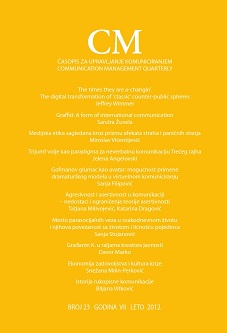Graffiti: A Form of International Communication
Graffiti: A Form of International Communication
Author(s): Sandra ŽuvelaSubject(s): Visual Arts, Theory of Communication, Globalization, Sociology of Art
Published by: Fakultet političkih nauka Univerziteta u Beogradu
Keywords: graffiti; rebellion; vandalism; tagging; Graffiti Hurts Organization;
Summary/Abstract: The purpose of this article is to discuss how graffiti has evolved from its primitive, prehistoric forms into an art form that evokes upheaval and yet expresses opinions that are insufficiently addressed by those in power and society in general. The subjects of this analysis will be different case studies from Latin America, United States, Singapore, South Africa and Serbia as examples of global problems and trends. Case studies and examples of prehistoric times will also serve as sources that will aid in identifying how graffiti has developed into a multinational form of communication. This analysis deals with graffiti as an expression of political and social discontent, as a form of general rebellion and vandalism as well as the paradoxical appreciation that is promoted by the Graffiti Hurts Organization. This specific form of expressive art connects the ‘underdogs’ of society to mainstream society through a constant battle to be heard, seen and to raise awareness of dissatisfaction. Those who instigate vandalism and reaction from the public through executing this form of art also instigate a constant battle of erasure of symbols, colourful signs and creative drawings thus proving society’s neglect.
Journal: CM Komunikacija i mediji
- Issue Year: 7/2012
- Issue No: 23
- Page Range: 23-36
- Page Count: 14
- Language: English

